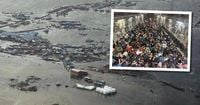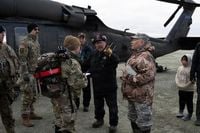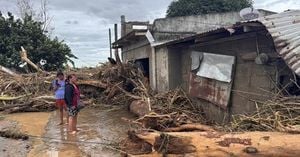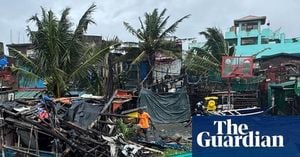When Typhoon Halong’s remnants barreled into Alaska’s western coast in mid-October 2025, few could have predicted the scale of devastation that would unfold. With hurricane-force winds and a surge of water topping six feet, the storm unleashed a humanitarian crisis across the Yukon-Kuskokwim Delta, disproportionately impacting remote Alaska Native villages and forcing an unprecedented evacuation effort.
The storm’s fury, centered around October 13–14, battered the region with winds exceeding 100 mph, flattening homes and inundating entire communities. According to the Alaska Division of Homeland Security and Emergency Management, hundreds of residents were displaced as the surging water pushed houses off their foundations and, in many cases, swept them out to sea. The hardest-hit villages—Kipnuk and Kwigillingok—saw catastrophic losses. In Kipnuk, 90% of homes, totaling 121, were destroyed. Kwigillingok lost a third of its housing stock, leaving families with nowhere to turn as winter’s chill crept in.
The human toll quickly became evident. State officials confirmed one fatality—a woman in Kwigillingok—and as of October 18, two individuals remained missing. Mark Roberts, incident commander at the State Emergency Operations Center (SEOC), summed up the stark situation: “We’ve confirmed that a number of homes cannot be reoccupied, even with emergency repairs, and that infrastructure has been compromised in several communities. Our focus now is making sure people are safe, warm, and cared for while we work with our partners to restore essential services,” Roberts told the National Guard’s news service.
Evacuation and rescue efforts began almost immediately, marshaling one of the largest airlift operations in Alaska’s recent disaster history. The Alaska National Guard and U.S. Coast Guard deployed a fleet of aircraft—two UH-60 Black Hawks, an HH-60 MEDEVAC, a CH-47 Chinook, and the massive C-17 Globemaster III—to evacuate residents from Kipnuk and Kwigillingok to Bethel, the regional hub. But Bethel’s shelters quickly reached capacity, triggering a second wave of airlifts to Anchorage and other cities less affected by the storm.
By October 15, 300 residents had been flown from Bethel to Joint Base Elmendorf-Richardson, where the SEOC, Alaska National Guard, and the American Red Cross of Alaska coordinated ground transportation to shelters across Anchorage. There, evacuees were met with warm meals, medical care, and support from the Municipality of Anchorage, the Department of Health and Social Services, and a host of local volunteer organizations. The American Red Cross, supported by FEMA, provided food, water, and medical care to those in need, while over 200 National Guard members distributed essential supplies.
In total, approximately 1,600 evacuees were moved to shelters in Anchorage—housed in schools, sports arenas, and even convention centers—with another 575 relocated to regional hubs. The scale of the operation was staggering. "This could be a prolonged relief operation lasting months as villages have been left inaccessible or unlivable as winter sets in," the Red Cross said in a statement, as reported by USA TODAY. Air evacuations, they added, were expected to continue for several days.
The logistical challenge extended beyond simply moving people. The Alaska Organized Militia, with about 75 personnel deployed across the affected areas, worked tirelessly to deliver sanitation supplies, tents, heaters, Meals Ready to Eat, and fuel to isolated communities. The Association of Village Council Presidents and the Western Alaska Disaster Relief Fund, backed by federal grants, channeled resources to the front lines, ensuring that food, fuel, and other essentials reached those in need. Nonprofits and tribal organizations played a crucial role, especially as many of the displaced—predominantly Yup’ik—rely on subsistence hunting and fishing for survival.
Governor Mike Dunleavy, who issued a state disaster declaration on October 9 and expanded it on October 13 as the scope of the disaster became clear, pledged to stand by the affected communities. On October 17, Dunleavy formally requested a Major Disaster Declaration from President Donald Trump through FEMA, seeking federal reimbursement for up to 75% of recovery costs, including home repairs, infrastructure rebuilding, and individual assistance for displaced residents. Alaska’s congressional delegation—Senators Lisa Murkowski and Dan Sullivan, and Representative Nick Begich—joined the call for swift federal action, stressing the unique cultural and subsistence impacts on Alaska Native communities. The Alaska Federation of Natives and 28 tribal groups echoed this plea, underscoring the storm’s threat to Indigenous lifeways.
President Trump, according to Governor Dunleavy, was closely monitoring the situation. "More help is on the way," Dunleavy wrote on X (formerly Twitter), reassuring residents that state and federal agencies were working in tandem to address immediate needs and lay the groundwork for recovery.
As the days wore on, the focus shifted from immediate rescue to long-term recovery. The SEOC and Alaska Organized Militia, with support from local and federal partners, launched community assessments to determine the full extent of the damage. Roads, communication lines, and air and seaport facilities had been battered, complicating relief logistics. Many families faced the grim reality of being unable to return home for months, if at all. “These families have experienced the worst days of their lives and are now moving away from their homes, schools, and neighbors,” Roberts said. “We’re doing everything we can to help them recover and to make sure they are welcomed and supported.”
The storm’s impact on Alaska’s rural communities is profound. Many villages, especially those along the coast, have long grappled with the effects of climate change—coastal erosion, thawing permafrost, and increasingly severe storms. Typhoon Halong’s devastation has only amplified those vulnerabilities. For the Yup’ik and other Indigenous peoples of western Alaska, the loss is not just material but cultural. Homes, boats, and fishing gear—essential for subsistence—were swept away, threatening ways of life that have persisted for generations.
While the road to recovery will be long and uncertain, the response has showcased the resilience and solidarity of Alaskans. Guardsmen, volunteers, and neighbors have come together in an all-hands effort to provide shelter, food, and care for those uprooted by the storm. As winter approaches, the challenge will be to ensure that every displaced family remains safe, warm, and connected to the support they need—however long it takes.
For now, the story of Typhoon Halong’s aftermath is one of hardship, heroism, and hope—an ongoing testament to the strength of Alaska’s people and the communities that bind them together.





